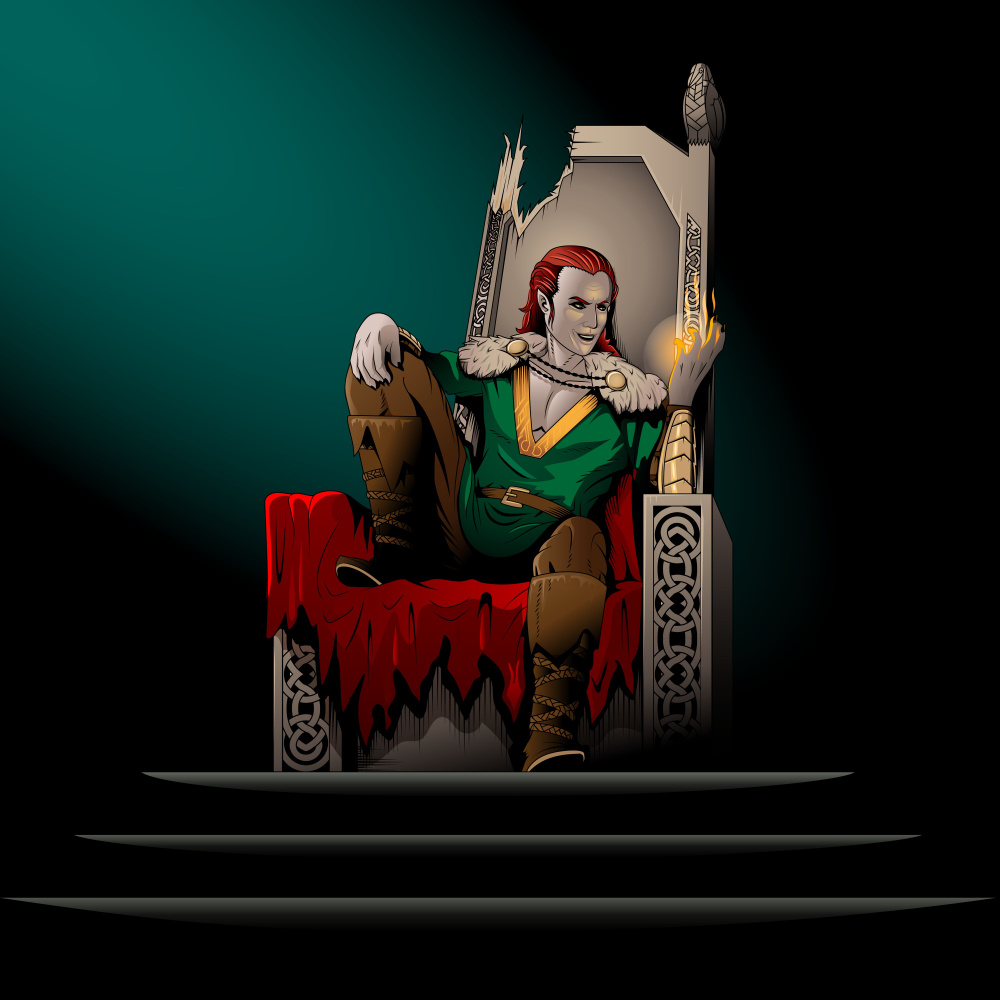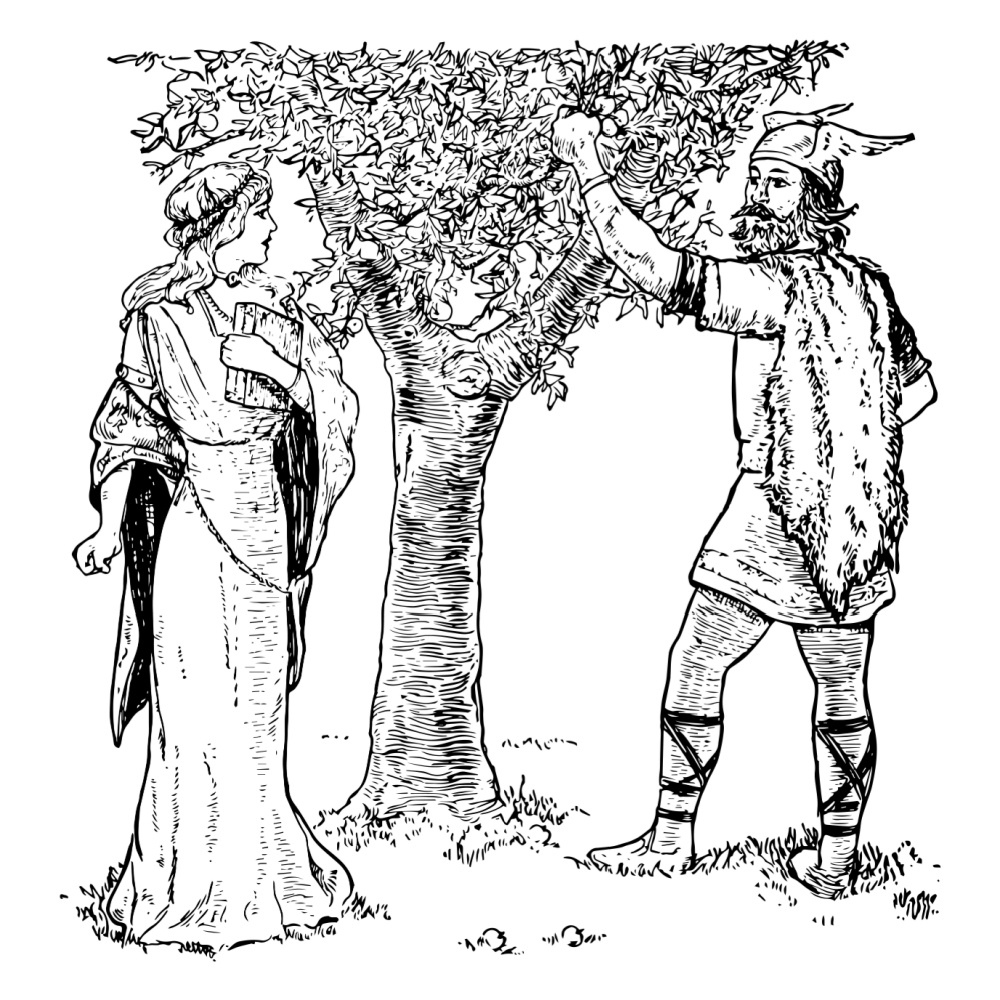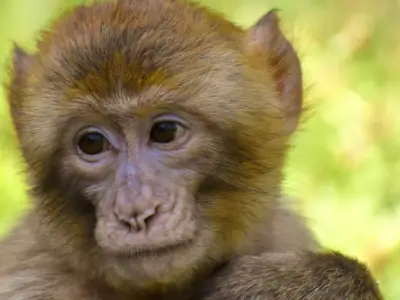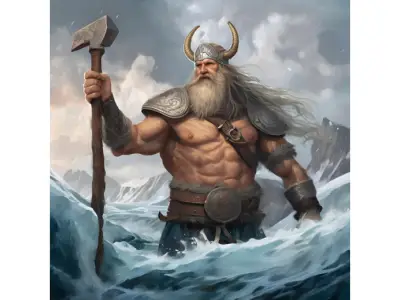Loki is one of the most fascinating gods in Norse mythology. To the ancient Norse, Loki was not necessarily a god to pray to but was rather a god that you’d pray to be delivered from, yet his popularity with modern audiences and lovers of the Marvel Cinematic Universe is undeniable.
But just how much do you know about the chief troublemaker of the Norse pantheon?

Table of Contents
Who is Loki?
Loki is portrayed as a trickster god within Norse mythology and is known for being cunning and unpredictable to the extreme. He’s a shapeshifter, a troublemaker and a sower of chaos and mischief. As you’d expect, he’s a central figure in many Norse myths and plays various roles within the stories that his shadow touches. For every tale in which Loki assists the gods of Asgard, another exists where he behaves in malicious ways towards them, causing problems that the other gods have to fix.
Generally, he’s numbered among the members of the Aesir: one of the two main groups of deities in Norse mythology (the other being the Vanir). However, Loki was not originally a part of the Aesir, unlike the brothers Odin, Vili and Ve. He is technically a Jotunn: one of the giants that hail from the realm of Jotunheim. He merely becomes associated with the Aesir as a result of his many dealings with them. He also fathered several significant monsters that played key roles in Ragnarok and the end of the Norse world, including the monstrous wolf Fenrir and the colossal Midgard Serpent.
What Does the Name Loki Mean?
The exact meaning of the name "Loki" in Norse mythology is not definitively known. Some scholars think that it’s related to certain words in Old Norse or other Germanic languages, but the exact linguistic connections are debated. It may be related to words meaning "knot" or "tangle", referencing Loki's ability to manipulate and confuse situations with his tricks. Some also propose links to Old Norse words meaning "fire" or "flame". One Old Norse text refers to him as "Loptr": meaning "air" or "sky", potentially linking him to the element of air or fire or echoing his ability to shift shape and disappear. Others point to the Norwegian word "loke", which means "ending", and the Old Norse word "lúka", meaning "to close", as these would reference Loki's betrayal of the gods at the end of the Norse myth. Alternatively, his name could relate to the Old English word "locc", which meant "lock of hair", possibly alluding to the myth where Loki cuts off the hair of the goddess Sif as a prank.
Who is Loki’s Father?
Loki is the son of the giant Fárbauti. This name has unclear origins but is probably connected to the Old Norse for "cruel striker" or "dangerous hitter" - which may link Fárbauti to lightning, storms, or dangerous natural forces. Fárbauti was the consort of Laufey (sometimes also known as Nál), who was Loki’s mother. Laufey's name also has connotations of leaves, suggesting connections to the natural world. Some texts speak of Laufey as being a goddess rather than a giantess. According to the ancient rules of patriarchy, Loki should be classified as a Jotunn, like his father, yet he took the name of his mother, suggesting that he may have chosen her people as his own. Both Fárbauti and Laufey are relatively mysterious figures in Norse mythology, and they are generally mentioned purely within the context of their son’s genealogies.
Want to put your knowledge of the Norse pantheon to the test?
Centre of Excellence has you covered.
Visit our Norse Gods and Goddesses Hub to sample the first 2 modules of our £127 Norse Mythology Diploma Course for FREE
Is Loki Thor’s Brother?
How right (or wrong!) did Marvel Comics get their portrayal of everyone's favourite Norse duo?! Well, just like in the comic book story, Loki and Thor are not siblings: Loki is the son of giants, while Thor is the son of Odin and the goddess Fjörgyn. However, Thor and Loki are sometimes described as blood brothers, having made a pact and sworn loyalty to each other. On some of Thor’s famous adventures, Loki accompanies him almost in the fashion of a modern-day sidekick. Despite his oath, Loki also often causes mischief for Thor, so in this respect, their portrayal within beloved films like Thor Ragnarok is quite accurate!
According to the Prose Edda, a collection of Norse myths and legends written by the Icelandic scholar Snorri Sturluson in the 13th century, Loki is brought to Asgard as part of a peace agreement between the Aesir and the Jotnar (giants). Loki is, therefore, arguably as much of a blood brother to Odin as he is to Thor, having also made a pact with the former.
However, the parallels with the Marvel Cinematic Universe end when we see that Loki and Thor were fated to fight on opposite sides at Ragnarok, the Norse end-of-days battle. Their strained relationship ultimately worsened to solidify their status as enemies.
Where is Loki From?
Surprisingly, there is no account of Loki’s birthplace in Norse mythology, although his parentage places him within Jotunheim. His father, Fárbauti, is a Jotunn. Jotunheim is one of the Nine Worlds in Norse cosmology and is inhabited by the Jotnar, a diverse group of supernatural beings. Loki's origin in Jotunheim is significant because it firmly associates him with the giants, despite his aforementioned strong connections with the Aesir gods of Asgard. In a sense, Loki’s unique origins allow him to bridge the gap between different realms and factions. In some interpretations of Norse tales, Loki’s shape-shifting abilities and lack of a permanent home (e.g. he’s also hinted to have lived in Asgard for a long time in the stories that call him Odin’s “blood brother”) are seen as further emphasising his fluid, ambient status in the myths. All told, while Loki's beginnings likely trace back to the realm of the giants, his boundary-crossing role means that his place of birth cannot be easily pinned down.
What Did Loki Look Like?
One of Loki’s most well-known powers was his ability to shapeshift, changing his appearance, gender, and even species at will. In some myths, Loki transforms into an elderly woman or animals like a seal, a salmon, a mare, and a fly. He was said to also change his image to impersonate other beings: a mischievous (and sometimes malicious) act that he used to manipulate situations and sow deceit. Loki therefore looked like whatever he wished to look like!
However, in some (often more modern) representations, he’s portrayed as a slight and rather handsome figure, typically with sharp, clever eyes and sporting fiery red hair and a beard. Any clothing he wore tended to be practical yet finely made and elegant: Loki is not usually portrayed as wearing armour. His grace contrasted with many of the other figures and monsters who could trace their origins back to the giants. It's important to note that these depictions are interpretations and artistic renderings, as the original myths tend to be more concerned with Loki's actions, motivations, and interactions than his physical attributes.
Is Loki a God?
Given Loki’s parentage, you’d be forgiven at this stage for asking the question, “Was he really a god at all?” and that’s a fair point! Loki is not of the Aesir, although he often lives among them and is included with them, but - despite his parentage - he’s also not wholly a jötunn or giant. In many ways, Loki is not fully one of the gods, nor is he fully a giant: he straddles a line between both, which speaks to his status as an outsider and trickster. However, the Prose Edda uses terms like "numbered among the gods" when discussing Loki, so most scholars do characterise him as a god, albeit a highly atypical one. Loki's powers and abilities demonstrate his godhood and the fact that he often accompanied the gods on their journeys also hints at this status. Yet his reputation and temperament set him apart from any other major Norse deity. This dual nature separates him from his fellows, and he was both ally and antagonist on many occasions before his support of the giants at Ragnarok cemented his status as an enemy.

What is Loki the God Of?
As you’ll have gathered, Loki is a multifaceted and ambiguous character with a range of roles and attributes: he has no straightforward domain like some other gods do and is not the god of any specific concept. However, he’s undoubtedly best known for his role as a trickster. As cunning and deceptive as they come, his actions cause disruption among gods and mortals, and his wit makes him a master manipulator. Because of this, Loki is sometimes associated with chaos and change, as he often serves as a catalyst for major events in Norse mythology. Another interesting recurring theme for Loki is that of boundaries and limits. His lupine offspring, Fenrir, is chained up, and Loki himself is bound before Ragnarok, highlighting his involvement in themes related to boundaries, constraints, and the inevitability of fate. Added to this, Loki’s modus operandi is clearly mischief and treachery that strays into downright evil territory, and some connect him to fire due to his red hair and unpredictable nature.
How Old is Loki?
As one of the Norse gods, Loki is treated as an immortal entity that ages differently than humans. He appears as an adult figure along the same lines as Odin, Thor and the other main Norse deities. This suggests that he is chronologically on par with them in terms of life phase. His status as the father of multiple offspring also positions him as an adult figure, although his youthful, nimble, and mischievous characteristics are more commonly associated with younger individuals. The truth is that Loki has no set age within Norse mythology, although his origins among the giants could imply that he was born several generations before the gods of the main Norse pantheon.
More Facts About Loki
- Loki’s three most terrifying children were the great wolf, Fenrir, the Midgard Serpent, Jormungandr, and the half-dead, half-living Hel. All three were born to the Jotunn, Angrboda. When Loki came to Asgard, Odin discovered these 3 horrors and did not treat them kindly. He cast Jormungandr into the sea and set Hel to rule over the shadowy realm of Niflheim. Whilst Fenrir was originally adopted by the Asgardians, their fear of his immense size led them to bind him and gag his mouth with a sword. Fenrir and Jormungandr went on to oppose the Aesir at Ragnarok, respectively slaying Odin and Thor, posing the interesting question: “Did the Aesir create the instruments of their own doom”?
- Loki’s most famous exploit is probably one of his most abhorrent: causing the death of Balder. Balder was the son of Odin and the half-brother of Thor and was universally beloved. He was, quite literally, the best of the gods. It was also foretold that he would die, despite his immortality. Anguished at this thought, Balder’s mother, Frigg, visited every entity in the universe to extract a promise from each that would ensure that none would harm her son. However, she committed one fatal oversight: she overlooked the mistletoe, believing that nothing so small could harm her mighty son. It wasn’t long before the capricious Loki heard of this “interesting” detail, and he set about whittling an arrow from mistletoe. Handing the arrow to Balder’s blind brother, Hod, Loki challenged the latter to throw the missile at Balder as hard as he could. Having no reason to believe that such a puny object would harm his brother, Hod flung the fateful arrow without hesitation… piercing Balder’s chest and slaying him.
- Aegir, the ocean giant, once held a feast to honour the Aesir, but the party atmosphere quickly turned sour when Loki became jealous of Fimafeng and Eldir, Aegir’s servants. Disliking the praise that the two were earning, Loki murdered Fimafeng and was banished from the hall. However, Loki was not one to be defeated easily, so he wormed his way back into the gathering and set about insulting as many of the revellers as possible. He kept this up until the arrival of Thor, whereupon he turned into a salmon and fled downriver.
- Sif, the wife of Thor, was famous for her golden hair, and these locks were prized by her husband. However, they were not so valued by Loki, who cut them off to entertain himself when he happened upon the sleeping Sif! Thor didn’t see the funny side of this joke and only relented from pursuing vengeance against Loki when the latter agreed to procure a headdress of golden hair for Sif. Loki agreed to this, enlisting the aid of the dwarves: mythological master craftsmen. Curiously, Loki seems to have been quite painstaking when it came to fixing his mistake, also bargaining for many other artefacts from the dwarves (including the spear, Gungnir; Odin’s ring, Draupnir; and a boar and a ship for Freyr) to make recompense.
- Continuing his interactions with the dwarves, Loki challenged two dwarf brothers to outdo the best work of their rivals. As the two brothers slaved away at the forge, Loki transformed into a fly to hinder them. His efforts succeeded to the point that their work upon the mighty hammer Mjöllnir was disrupted, and the handle of the hammer was far shorter than intended. However, this defect failed to dampen the enthusiasm of the gods, who declared it a masterpiece. Having lost his bet, Loki declined to honour his deal and fled from the brothers.
- When a giant offered to build a wall around Asgard in exchange for the Sun, Moon and the goddess Freya, the gods agreed to his terms on condition that he completed his work by the first day of summer: an impossible task, or so they thought! To their dismay, summer approached and the giant’s labours neared completion, so the gods called upon Loki. Shifting his shape into that of a mare, Loki lured the giant’s stallion into the woods, resulting in Loki giving birth to Sleipnir - Odin’s famous 8-legged steed - and Thor having to step in to crush the enraged giant.
- When the Jotunn, Skadi, sought to avenge her father’s death at the hands of the Aesir, she agreed to accept compensation on the condition that the gods could make her laugh. Skadi clearly thought that this was an impossible demand. However, one goat, one rope, and his own “extremities” later, Loki achieved the task!
Does Loki Die?
Yes, even the slippery Loki will eventually fall foul of fate, dying during Ragnarok, the apocalyptic battle that marks the end of the world and the subsequent rebirth of the cosmos. In fact, Loki's role in Ragnarok is significant. After causing Balder’s death, he escapes from his bonds before the battle begins and leads an army of giants, monsters (including Fenrir and Jormungandr) and the dead out of Hel to war against the Aesir gods. During the battle, Loki will face off against the god Heimdall and will ultimately meet his match. Loki will perish upon Heimdall's sword… but not before he inflicts a fatal wound upon his conqueror. Loki's death represents the culmination of his role as an agent of chaos and unpredictability: it’s an essential part of the cycle of destruction and renewal and is seen as a just punishment by the gods for his role in Balder's death and his general betrayal of them. Some scholars think that Loki may be reborn after Ragnarok during the new world that emerges, along with some of the other gods, although - perhaps fittingly - there appears to be no consensus.
If you’d like to find out more about Loki and the rest of the Norse pantheon, then be sure to visit our Norse Gods and Goddesses hub, where you can access the first two modules of our fantastic Norse mythology diploma course absolutely FREE of charge.
Want to put your knowledge of the Norse pantheon to the test?
Centre of Excellence has you covered.
Visit our Norse Gods and Goddesses Hub to sample the first 2 modules of our £127 Norse Mythology Diploma Course for FREE





